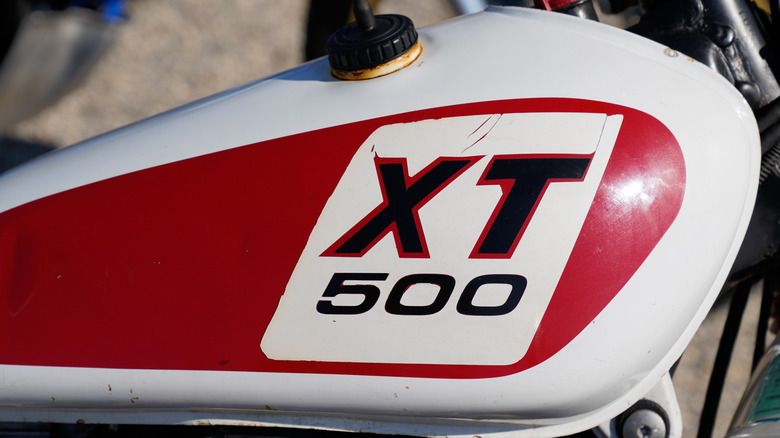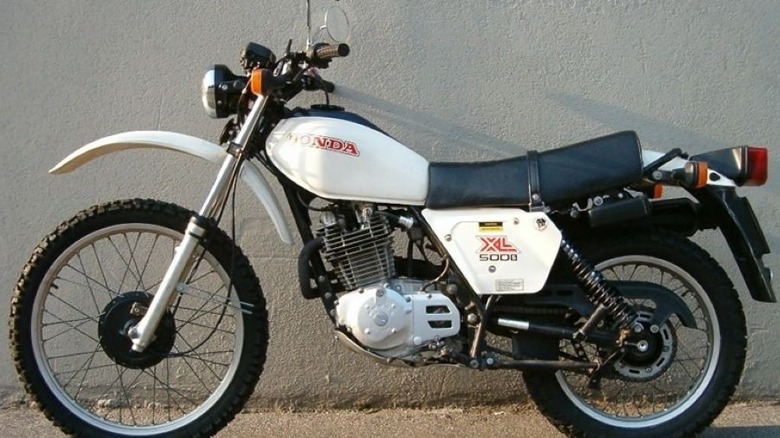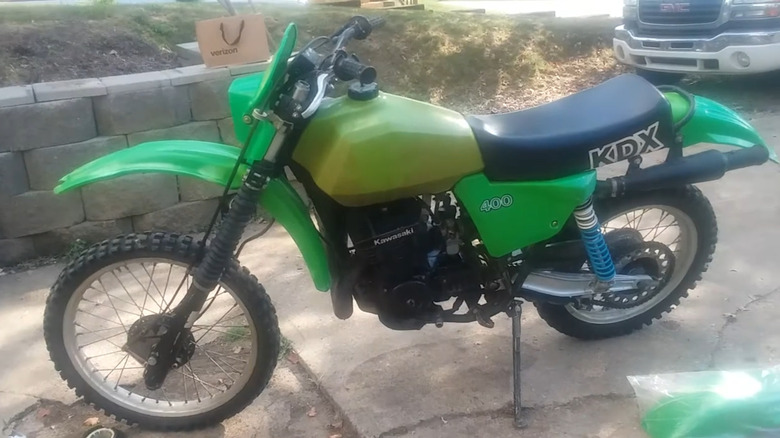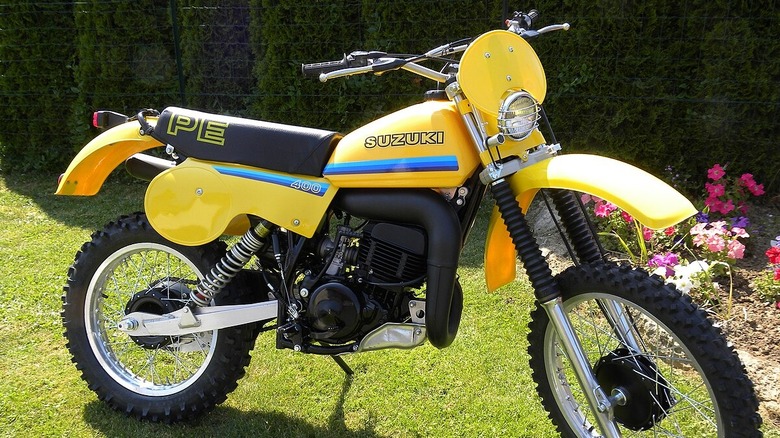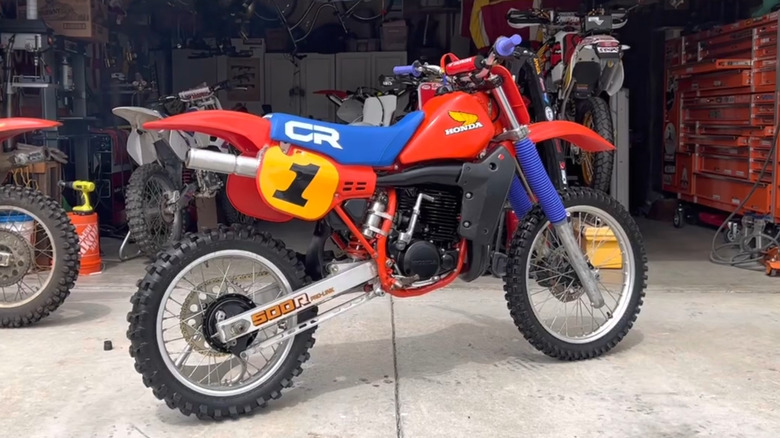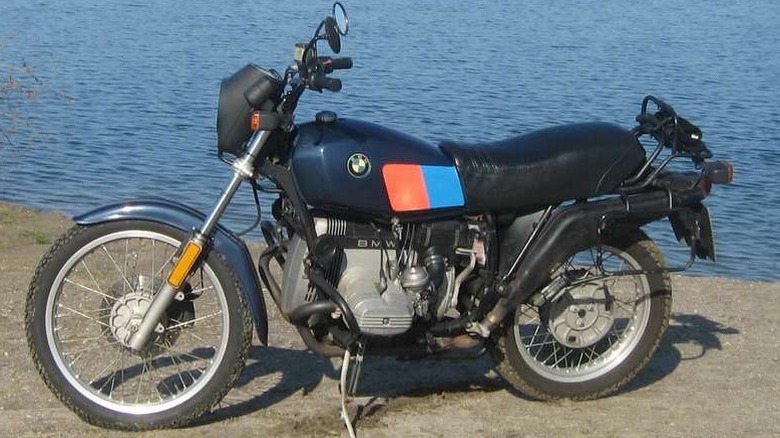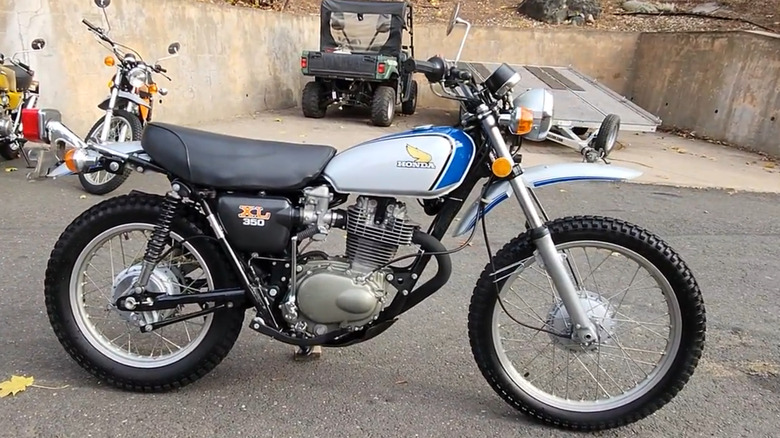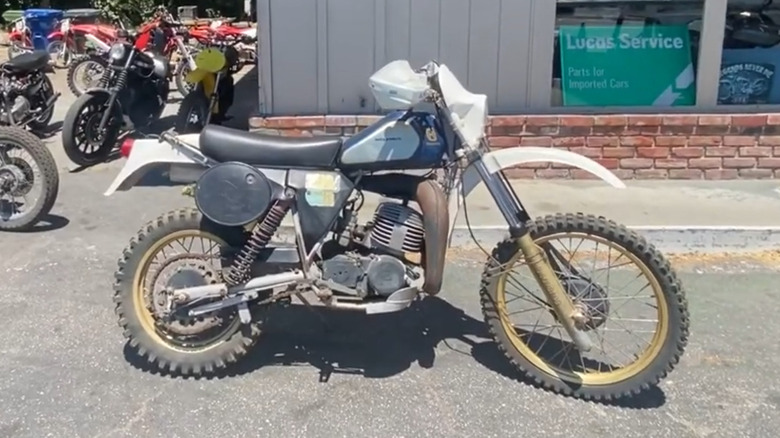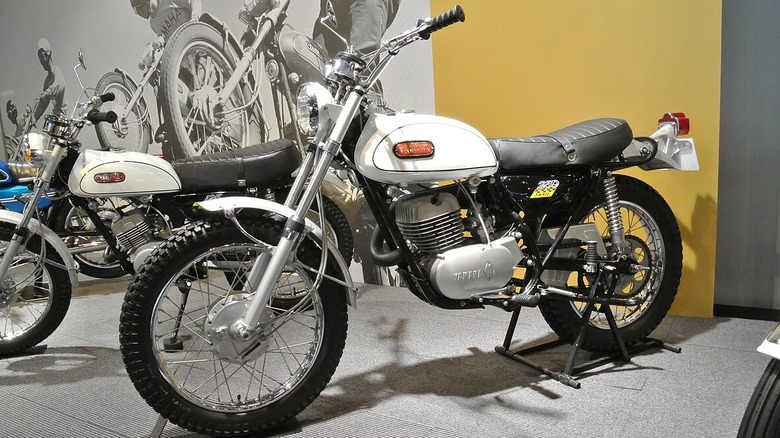8 Alternatives To The Yamaha XT500
The 1970s were a monumental decade for off-road motorcycles. The enthusiasm that had built in Europe for motocross in the 1960s was spreading to the Americas. Motorcycle companies were investing significantly in performance off the beaten path. Yamaha was at the forefront of the battle, producing bikes that paved the way for off-road motorcycles.
The Yamaha XT500 won the first Paris-Dakar Rally. That fact alone should make any off-road motorcycling fan sit up. Paris-Dakar is legendary for its grueling and brutal terrain. Taking the title in any year, let alone the inaugural 1979 contest, is a chapter of its own in a motorcycle's hall of fame application. The fact that the XT500 won Paris-Dakar the following year as well affirms that it was no fluke.
Introduced for the 1976 model year, the XT500 featured a single-cylinder, single-overhead-cam, two-valve setup that produced approximately 40 horsepower. Weighing just 300 pounds dry, the power-to-weight ratio was respectable, and the XT500 became famous for its ruggedness and longevity. Decades after its Paris-Dakar laurels, it's become one of the rare vintage machines to evolve into a classic. The Yamaha XT500 is still sought after for its reliable repairability and vintage charisma.
And yet, other motorcycles of the era have the same simple charms, and some even have a similar pedigree. If a vintage off-road machine is your next pet project or weekend ride, what else might tempt you? We've scoured the used market to identify which bikes rival the XT500 in terms of fun, form, and finances.
Honda XL500S
When it comes to the Big Four manufacturers — Honda, Suzuki, Yamaha, and Kawasaki — you usually don't have to look far to find similar bikes. While Yamaha was building a legend with the XT500, Honda had something comparable in its stable. After all, Yamaha's fellow Japanese manufacturer was nailing the whoops and jumping the doubles right alongside Yamaha on the motocross circuit, and all that know-how coalesced in the 1979 Honda XL500S.
Designed for both on-road and off-road riding, the XL500S was a dual-sport motorcycle. According to Cycle World's original profile in September 1979, it was the "closest yet to the perfect on-off road machine." The S came equipped with mirrors, lights, and the other trappings of road legality, but the heart of the matter remained the 32 hp, 500cc single-cylinder engine shared by its near-twin, the XL500, which would go on to establish itself as one of the most dominant motocrossers of the era.
While the XL500S may not have enjoyed the same career as the XT500, it still offers a great deal of on and off-road fun with the added benefits of Honda reliability and repairability. The XL500S, in particular, is a tough contender to beat. A restored example with a clean title fetched a reasonable $3,800 from Bring a Trailer back in 2023, and even beat-up examples can be acquired for far less. So, if you've spotted one leaning against the barn around the corner or in the local sale ads, it's definitely worth considering.
Kawasaki KDX 400
Kawasaki dropped its KDX 400 enduro bike off at the pool in 1979, and it made a neon green splash. It was Kawa's first foray into enduro territory, and it rode in the same packs as the Yamaha XT500 and Honda XL500S. It was the first of a new line, which tends to equate to broken motorcycles. Still, the August 1979 edition of Cycle World praised the upstart KDX as "an exceptionally good first year bike" with the potential to be "an instant enduro winner or fun play bike." While there's no chance it stands up against modern enduro bikes, that fun play part sounds mighty appealing.
The KDX 400, in its initial form, lasted only two production years: 1979 and 1980. However, it evolved with increasing displacement and improved mechanical components in later forms. The engine power was competitive with that of even the larger displacement enduros. The KDx 400 made an estimated 40 hp and 31 lb-ft of torque in its first year.
The air-cooled, kick-starting KDX400 might not be for everyone. Few lamented the rise of the electric starter, and any of the bikes this age lack the modern bells and whistles. However, if you still have a strong leg and the wherewithal to use it, a prime 1979 KDX400 sold for $4,250 in 2021, while J.D. Power pins the Very Good value at $2,490. Finding the right one can be even more cost-effective if a project is what is on the docket.
Suzuki PE series
Suzuki also participated in the enduro game in the late 1970s and early 1980s. The Pure Enduro, or PE series, introduced several bikes in the same vein as the XT500. The PE came in several displacements, including 175cc, 250cc, and 400cc editions. While none are as large as the XT500, one of the things you need to know before buying your first motorcycle is that displacement isn't everything.
The PE 250 made its debut in 1977, while the 175 was in production from 1978 to 1984. Suzuki brought forth the PE 400 in 1980. Despite Cycle World's initial reservations about its handling, the PE 400, like all the bikes in the PE series, carries with it a unique charm that sets it apart from modern machines. If you're dedicated to the vintage enduro lifestyle, you understand that comfort is not the primary concern.
The PE400 certainly wasn't one of the most powerful bikes Suzuki ever made, but it was popular in the Commonwealth countries. Not many made it to the United States. Anyone resigned to the vintage experience could look out for the PE 400 at Mecum. This 2021 listing featured a mint 1982 Suzuki PE 400. No information is available on the price, but bikes of this age in unrestored or survivor condition are often valued in the low single digits.
Honda CR500
If the PE series is a tad smaller and more restrained, the CR500 is the opposite. While closer in displacement to the XT500, Yamaha's enduro shares a mission with Suzuki's PE series. Thanks to our admittedly subjective criteria, which lump classic off-road motorcycles and dirt bikes into a single category, Honda's CR500 enters the list as a vintage off-roader to appease those looking to grip and rip.
The Honda CR500 was a lightweight motorcycle with a suspension system built to tackle the most brutal lumps and jumps of motocross and trail riding. It was a glorious machine, but its relatively large displacement combined with two-stroke twitchiness demanded the most of riders. If an adventure bike or trail experience is up your alley, Honda has built several iterations of its Africa Twin, but some off-road machines seem easier to get hurt on (or fly off of), and the CR500 is their king.
However, in the right hands, the CR500 can scream. As a two-stroke, it is mechanically simpler than the XT500. An amateur mechanic with some acreage and excellent safety gear could feast on one of these bikes. Not to mention the old-school track ripper hanging around the pits on Vintage Night at the local motocross track.
Fans still swear the CR500 is the best dirtbike ever made. Unfortunately, that translates to the secret being out on these bikes. Despite solid production numbers, they're not necessarily getting cheaper. According to Cycle World, an in-the-crate 2001 CR500R went for an eye-watering $78,100 on eBay in 2025.
BMW R G/S80
Great off-road motorcycles weren't just coming from Japan. The 1980 release of the BMW R80G/S ignited the market for dual-sport road machines and practically invented the adventure motorcycling category.
Today, high-tech adventure bikes take you anywhere you want to go (and sometimes places you don't) with the latest comfort, navigational, and engineering doo-dads front and center. That niche of the motorcycle market has generated entire lines of motorcycles, products, and equipment based on that lifestyle. If serving as the genesis of one of the main tributaries of the motorcycling ecosystem isn't enough, the R80G/S may have also saved BMW Motorrad.
BMW took the single-cylinder concept and turned it on its side, literally. The Red Devil prototype R80G/S used the flat twin-cylinder configuration that is famous in BMW's modern bikes. Flat engines aid balance at low speeds while reducing the odds of a tipover. Combine that with an extra cylinder generating power in a harmonious 180-degree boxer configuration, and you have a motorcycle with more power, a lower center of gravity, and smoother operation than a single-cylinder model. It had the grunt needed for off-roading and the soft power for the highway.
The modern BMW R1250 GS represents its ancestor, the R80G/S, spectacularly well as one of BMW's leading offerings, a half century later. That means that BMW has stuck to this formula ever since the R80G/S's financial success allowed the motorcycle division to remain open. If you want to find one, just remember the market for adventuring BMWs is broad, deep, ancient, and fraught with thrashed bikes.
Honda XL350
The Honda XL500 may be closely aligned with the Yamaha XT500, but Honda used another lightweight off-roader as the basis for its development. The Honda XL350 is a dual-purpose motorcycle that claimed the capability to cruise at 70 mph on highways, we imagine with a substantial clatter and a set of white knuckles. That same power on trails lined with trees and pocked with divots and deep lines will go much further.
The 1974 Honda XL350 produced between 22 and 30 hp at 7,000 rpm with a 348cc air-cooled single-cylinder engine. It claimed an out-of-the-box max speed of 80 mph, but we wouldn't recommend it on anything less than a factory-restored, mechanically excellent specimen. At a featherweight 314 pounds, it's not necessarily a leg-breaker if you get off-camber on a bump.
Honda built the dual-sport XL350 between 1974 and 1978, and it has all the charm of the era. An excellent condition 1974 XL350 demanded $3,200 in 2025. The XL350 combined road bike charm with off-road capability, and remains a beloved member of the vintage dual-sport stable.
Husqvarna 250 WR RT
Husqvarna originated as an arms factory for the Swedish government in 1689. Centuries and many business decisions later, the brand has evolved to specialize in manufacturing motorized implements, including lawn equipment and competitive dirt bikes. From developing its first motorized bicycle in 1903, Husqvarna bikes now grace podiums and trails worldwide.
Part of Husqvarna's legacy is the series of 250cc off-road bikes it built during the 1970s. The WR 250 Road-Trail (RT) was part of the Swedish invasion of motocross popularity developed during the 1970s. A few of the Swedish builders' bikes made it to North America in 1966, but the 250 WR made it a one-two punch of Scandinavian engineering.
It wasn't necessarily an underdog story: Husqvarna had been a pioneer in the burgeoning motocross sport in Europe for some time. Today, Husqvarna remains one of the smaller-scale manufacturers competing in off-road racing and producing interesting dual-sport machines that compete well with the big names. Plus, it makes a heck of a lawn mower. Lawn tools aside, Husqvarna's 250s of the early '70s strike that same pedigreed tone and retro appeal as the XT500.
Yamaha DT-1
Yamaha's DT-1 proved to be the manufacturer's first entry into the off-road game, and it wasn't long before the XT500 came along to benefit from what it learned. With motocross and trail riding on the rise alongside suspension and engine technology, everyone entered the dual-sport and dirtbiking arena. Yamaha put out the DT-1 in October 1967. Along with BMW, the DT-1 would help spark the trail and off-road riding craze that continues to this day.
The template for Yamaha's four-stroke, single-cylinder 250cc displacement would become a stalwart class in racing and hobby riding alike. The best part for Yamaha was that the little dirtbike was an instant success. The company sold as many as 50,000 units per year at its peak, which coincided with the baby boomer population entering adolescence, a bit of disposable income, and a desire for adventure.
The DT-1 introduced an entire generation to the joys of off-road riding. Today, its classic lines, semi-knobbed tires, and oval tear-drop tank recall a simpler time. Modern DT-1s are somewhere between museum classic and barn find, with examples that don't surprise anyone crossing the block at Mecum or in the back of the local ads.
